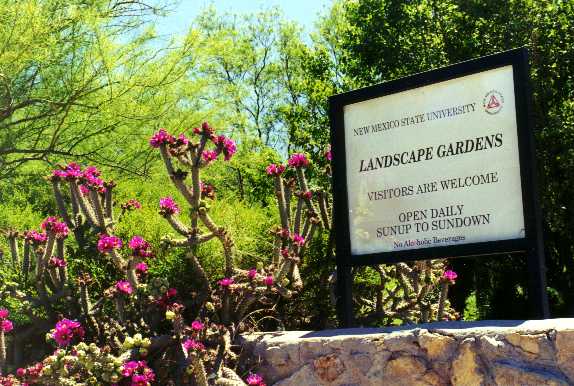Demonstration Garden

Fabian Garcia Science Center
The Fabian Garcia Science Center is part of the New Mexico State University (NMSU) Agricultural Experiment Station. Located just west of Main Street, on University Avenue, the Complex houses the Landscape Demonstration Garden and facilities for cotton, onion, pecan and chile research. Fabian Garcia, for whom the Center is named, began researching these crops over 100 years ago, and his work is in evidence to this day.
Fabian Garcia was one of five members of the first graduating class of New Mexico College of Agriculture and Mechanical Arts (now NMSU), in 1894. As an undergraduate, Garcia began developing the "New Mexican" chile-pod type still grown in the state today. After graduation, Garcia was employed by the Agricultural Experiment Station, and was named director in 1913.
Garcia was station director until his retirement in 1945. Researchers such as Roy Harper, developer of the New Mexico No. 6 chile, carried Fabian Garcia's work further, as did Roy Nakayama, who developed the NuMex Big Jim, NuMex R Naky, and NuMex L-4, but it is Fabian Garcia who is credited with laying the groundwork for New Mexico's success in the commercial production of onions, cotton, pecans, and of course, chile.
Landscape Demonstration Garden - Fabian Garcia Science Center
The Landscape Demonstration Garden at the Fabian Garcia Science Center is a relatively new addition of NMSU's Agriculture Experiment Station. Conceived in the imaginations of Agronomy and Horticulture professors in 1983, retired Minnesota landscape architect Roy Anderson donated his time to design the garden. With faculty and community donations of time and materials, the Landscape Demonstration Garden opened in 1985, and continues to engage College of Agriculture and Home Economics students in a "living laboratory" environment. The garden involves students in meaningful work that complements their academic experience and develops skills for careers in agriculture. In addition, the garden serves the community as an area in which to learn gardening methods and view plant material appropriate to the southern New Mexico climate, thus playing a vital role in fulfilling New Mexico State University's obligation as a Land Grant Institution: To serve and educate the community.
The Landscape Demonstration Garden displays over 200 labeled genera of trees, shrubs, and groundcovers. Each plant is labeled to provide the visitor with the specimen's scientific and common name, and hardiness zone, as well as symbols indication the ornamental use. For example, the apple and bird symbols indicate a fruit-bearing plant that attracts birds.
Education Theme Gardens
In 1997, an award from the USDA provided funding for the design and installation of five (5) education theme gardens, known collectively as the Dig and Discover Project. The project's principal objective was to provide experiential learning for undergraduate Agronomy and Horticulture students, while simultaneously creating a stronger link between higher education and K-12 students. The history and math gardens were designed by a graduate student, and undergraduates designed the remaining three gardens. Students were responsible for garden theme conception, design and installation methods, and development of relevant, age-appropriate activities.
The A-MAZE-Ing History Garden
Designed By: Laura Davis
Completed: August 1998
This garden commemorated Don Juan de Onate's historical exploration of the Southwest United States. Planted the first year in German millet, and the second year in corn, preliminary activities focused on explorers and their quests, and included flag making. Activity stations within the Maze included a buried chest, where young explorers "discovered" the same type of treasure that Onate's explorers found: Corn, squash, and pinto bean seeds.

Earth Math
Designed By: Laura Davis
Completed: September 1999
The Earth Math Garden's formal design reflects basic geometric and algebraic principles. Activities focus on concepts such as circumference, radius, diameter, and right angles.
Herb & Dye Gardens
Designed By: Cathy Feser
Completed: May 2000
Plants in the Herb Garden are used in the culinary and medicinal arts, and exhibit a variety of leaf colors, textures, and scents. Activities focus on the senses of touch, smell, and taste. The Dye Garden , set within the Herb Garden, features plants commonly used for the dyeing of cloth. Activities teach students about various plant parts and the color produced from each part.
Sculpture Garden
Designed By: Carolyn Taylor
Completed: May 2000
The Sculpture Garden displays creativity with plant material. Junipers form the stationary background for the University's acronym, "sculpted" in bas-relief with seasonally changed annuals.
The U.S.-Mexican Garden
Designed By: Daniel Anaya, Kerri Dell, Luke Mauter, and Nikki Pryor (Fall 1999)
Construction Pending: Anticipated Fall, 2000
This garden will be a colorful display of mirror-imaged flowering shrubs, with plants labeled in English on one side of the garden, and in Spanish on the other side. Activities center on culture and language arts.